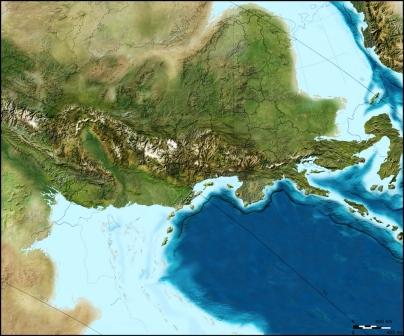
| Palaeos: Paleozoic |  |
Pennsylvanian Epoch |
| Carboniferous Period | Gzhelian Age |
| Page Back | Back: Kasimovian | Back: Mississippian | Up: Pennsylvanian | Unit Home |
| Page Next | Next: Asselian | Next: Cisuralian | Timescale |

Meganuera monyi
wingspan 75 cm
Stephanian of France.

Eastern Euramerica (modern day Europe) as it appeared in the Gzhelian. Map © Ron Blakey
The Gzhelian is the youngest stage of the Pennsylvanian, the youngest subsystem of the Carboniferous. The Gzhelian lasted from 303.9 ± 0.9 to 299.0 ± 0.8 Ma. It follows the Kasimovian age/stage and is followed by the Asselian age/stage, the oldest subdivision of the Permian system. The Gzhelian is more or less coeval with the Stephanian stage of the regional stratigraphy of Europe.
The aridification of the climate which began in the Kasimovian, continued in the Gzhelian. This change resulted in a major turnover in the structure of the Coal Swamps. The Lycopsids which so dominated the Baskirian and Moscovian ages were practically reduced to one genera Sigillaria. Ferns replaced the Lycopsids in abundance with the latter being reduced to the wettest parts of the swamps. The dominance of the Ferns was only temporary as Seed Plants eventually supplanted them, remaining dominant to the present day.
At the very end of the age, the Coal Forests underwent a resurgence, expanding mainly in eastern Asia, notably China; they never recovered fully in Euramerica. The Chinese Coal Forests continued to flourish well into Permian times. This resurgence of the Coal Forests seems to have coincided with a lowering of global temperatures, coinciding with a return of extensive polar ice in southern Gondwana. This lessening of the greenhouse effect maybe due to massive coal deposition extracting much carbon dioxide from the atmosphere.
The Gzhelian was also a time of glaciation with the poles extremely cold (particularly in the south). The equatorial regions remained wet and warm. This period of glaciation persisted into the Permian. Yogi111211
| Page Back | Unit Home | Page Up | Page Top | Page Next |